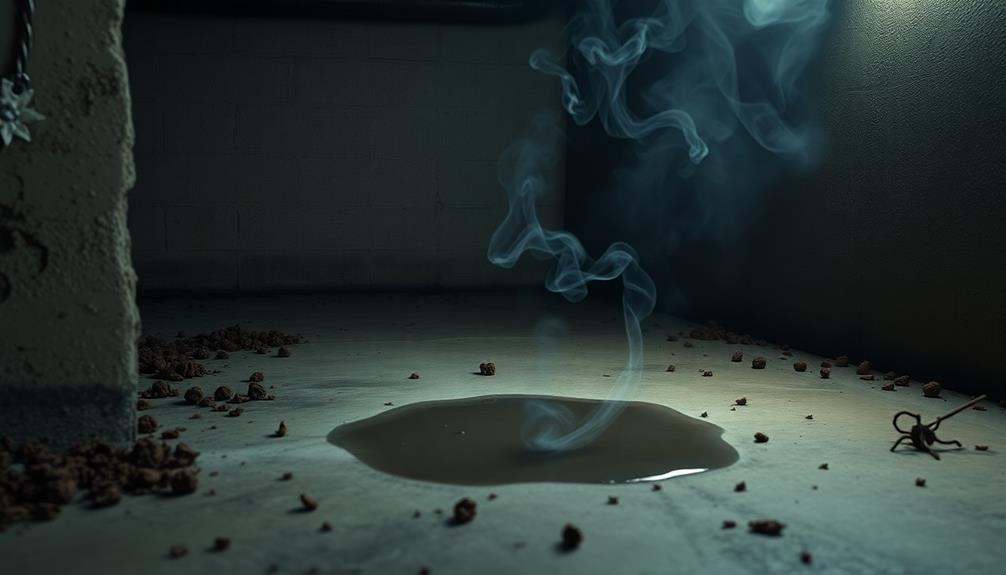If you notice a musty smell coming from your dog, it could indicate a yeast infection. This odor often resembles moldy bread or corn chips, and it usually occurs in warm, moist areas like ears, paws, or skin folds. The smell is caused by the overgrowth of yeast called Malassezia pachydermatis, which thrives in humid conditions. Along with the odor, you might see signs like itching, redness, or swelling. It's important to pay attention to these signs as they can point to potential health issues. Stay tuned to discover effective ways to manage this problem and keep your furry friend healthy!
Key Takeaways
- A yeast infection smell in dogs is often described as musty, resembling moldy bread or corn chips.
- The odor is primarily caused by the overgrowth of the yeast Malassezia pachydermatis on the skin.
- Moisture and humidity exacerbate the smell, particularly in areas like ears, paws, and skin folds.
- Accompanying symptoms may include excessive itching, redness, and inflammation, indicating an underlying health issue.
- Regular grooming and veterinary check-ups are essential to manage odors and prevent infections.
Introduction

If you've noticed a peculiar smell coming from your dog, it could be a sign of a yeast infection. This musty odor often smells like moldy bread or corn chips and usually comes from areas where yeast overgrowth occurs, like the ears, paws, and skin folds.
When your dog has a yeast infection, the smell might be accompanied by excessive itching, redness, and inflammation. It's important to be aware of your dog's diet, as certain foods can contribute to allergies and yeast infections; consider looking into best dog food for allergies to help manage these issues effectively.
It's essential to pay attention to these signs, as they help you identify the problem. While a musty smell often indicates a yeast infection, remember that other skin conditions can create similar odors. So, don't jump to conclusions just yet!
To help manage the smell and maintain your dog's health, regular cleaning and grooming are important. Keeping your dog's ears and skin folds dry can prevent yeast overgrowth and make your furry friend more comfortable.
If you notice that your dog's smell persists despite your efforts, it might be time to consult your veterinarian for advice. Taking these steps can ensure your dog stays happy and healthy, free from the uncomfortable effects of a yeast infection.
Description of the Smell

Describing the smell of a yeast infection in dogs reveals a distinct and unpleasant odor that many owners find hard to ignore. This smell is often described as musty, similar to corn chips or moldy bread.
It can be quite overwhelming, especially if your furry friend has yeast overgrowth in areas like their ears, paws, or skin folds. The culprit behind this yeasty odor is a type of yeast called Malassezia pachydermatis, which thrives in warm, moist environments.
Yeast infections can be exacerbated by environmental factors such as humidity and moisture, which create an ideal breeding ground for this yeast. If you notice this strong odor, it mightn't just be a passing issue.
The smell often gets stronger when there's moisture around, as yeast loves dampness. Even if you can't see any symptoms, that yeasty smell can be a warning sign of an underlying yeast infection that needs attention.
Source and Composition

The source of the musty odor associated with a yeast infection in dogs primarily comes from the overgrowth of Malassezia pachydermatis, a type of yeast naturally found on their skin.
When conditions are warm and moist, this yeast can multiply rapidly, leading to an unpleasant smell. You might notice that the odor resembles corn chips or moldy bread, which can be quite strong and hard to ignore.
Additionally, certain dietary factors can influence a dog's skin health, as oatmeal is a healthy grain that can aid in digestion and overall wellness.
As the yeast overgrows, it produces metabolic byproducts that contribute to the distinct smell.
Infections can also lead to inflammation and secondary bacterial growth, complicating the scent profile even more. If your dog has a yeast infection, you may see they've greasy or oily fur, which can amplify the musty odor.
Regular grooming and hygiene practices are crucial in managing the smell.
By reducing moisture and yeast buildup on your dog's skin and coat, you can help keep that odor in check.
Typical Scenarios or Environments

Yeast infections in dogs often thrive in warm, humid environments, making certain scenarios particularly conducive to their development.
You might notice a distinct yeasty smell if your dog has a yeast infection, especially in areas with excess moisture. For dogs with skin folds or floppy ears, the moisture can easily accumulate, creating a perfect spot for yeast growth.
You may find that the odor is stronger in these areas, and it often comes with other signs like itching and inflammation. These symptoms might be telling you that your furry friend needs some extra care.
If your dog spends a lot of time outdoors, especially in wet grass or muddy areas, this can increase the risk of a yeast infection in dogs.
Regular grooming is essential to keep your pup clean and comfortable. By giving special attention to skin folds and ears, you can help reduce localized odors associated with yeast infections.
Emotional or Cultural Associations

Noticing a distinct odor from your dog can spark various emotional reactions. When you catch a whiff of that musty smell, often likened to corn chips or moldy bread, it can lead to feelings of discomfort. You might worry about your pet's health and cleanliness, fearing that others may judge you for neglecting hygiene. This smell can create emotional distress, highlighting potential underlying health issues like a yeast infection that need attention.
In many cultures, a strong odor from pets is linked to beliefs about cleanliness, urging pet owners to take a proactive approach. You may feel the pressure to seek remedies or veterinary care to address the situation.
Recognizing this odor can motivate you to adopt better hygiene practices for your furry friend. Regular veterinary check-ups are essential to ensure your dog's overall health and well-being.
In the end, understanding the emotional and cultural associations with your dog's smell can foster a deeper connection to their health needs. Embracing this awareness not only helps you care for your pet but also eases any embarrassment you might feel. Your dog deserves the best, and you can provide that!
Health or Safety Considerations

A strong, musty odor from your dog can signal a yeast infection, often associated with an overgrowth of Malassezia yeast. This smell can resemble corn chips or moldy bread, particularly noticeable in your dog's ears, paws, and skin folds.
If you notice this odor, it's crucial to act quickly. Left untreated, a yeast infection can lead to skin infections or other health issues, including those related to your dog's immune system.
As a dog owner, you should prioritize regular veterinary check-ups. Persistent odors can indicate deeper problems, like allergies or immune deficiencies, that need professional attention.
Cleaning and drying the affected areas can help reduce the odor and prevent moisture buildup, which encourages yeast growth.
Final Thoughts

Addressing a yeast infection smell in your dog is vital for their overall health and well-being. If your furry friend starts to emit a musty odor, especially from their ears or paws, it's a sign you shouldn't ignore.
This smell often resembles corn chips or moldy bread, which can be alarming. Along with the odor, look for signs like itching, redness, or discharge. These symptoms can indicate an infection that may need your attention.
Regular grooming can help keep yeast infections at bay, but if the smell persists despite your best efforts, it might hint at an underlying issue. It's essential to act quickly, as early intervention can prevent further complications or secondary infections.
Your dog's comfort is important, and you want to ensure they feel their best. Never hesitate to consult your veterinarian if you're worried. They can provide the right diagnosis and treatment plan tailored for your dog.
Frequently Asked Questions
Can You Smell a Yeast Infection in a Dog?
Yes, you can smell a yeast infection in a dog. It often has a musty odor, resembling corn chips or moldy bread. If you notice this smell, check for other symptoms and consult a vet.
What Kills Yeast Infection in Dogs?
To kill a yeast infection in dogs, you can use antifungal medications like ketoconazole or fluconazole, apply medicated shampoos, and integrate natural remedies like apple cider vinegar. Keeping your dog clean and dry is essential too.
What Smell Does a Yeast Infection Smell Like?
A yeast infection often smells musty, like moldy bread or corn chips. You'll notice this odor in affected areas, which may also show signs of irritation. If it's persistent, consult your vet for guidance.
How Do I Know if My Dog Has a Bacterial or Yeast Infection?
To determine if your dog has a bacterial or yeast infection, observe symptoms like intense itching, discharge type, and odor. Consulting your vet's crucial for accurate diagnosis and appropriate treatment tailored to your dog's condition.









